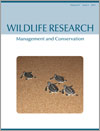Context . Over the past two decades, an increase in the number of resident (non-migratory) Canada geese (Branta canadensis) in the United States has heightened the awareness of human–goose interactions.
Aims . Accordingly, baseline demographic estimates for goose populations are needed to help better understand the ecology of Canada geese in suburban areas.
Methods . As a basis for monitoring efforts, we estimated densities of adult resident Canada geese in a suburban environment by using a novel spatial mark–resight method. We resighted 763 neck- and leg-banded resident Canada geese two to three times per week in and around Greensboro, North Carolina, over an 18-month period (June 2008 – December 2009). We estimated the density, detection probabilities, proportion of male geese in the population, and the movements and home-range radii of the geese by season ((post-molt I 2008 (16 July – 31 October), post-molt II 2008/2009 (1 November – 31 January), breeding and nesting 2009 (1 February – 31 May), and post-molt I 2009). Additionally, we used estimates of the number of marked individuals to quantify apparent monthly survival.
Key results . Goose densities varied by season, ranging from 11.10 individuals per km2 (s.e. = 0.23) in breeding/nesting to 16.02 individuals per km2 (s.e. = 0.34) in post-molt II. The 95% bivariate normal home-range radii ranged from 2.60 to 3.86 km for males and from 1.90 to 3.15 km for females and female home ranges were smaller than those of male geese during the breeding/nesting and post-molt II seasons. Apparent monthly survival across the study was high, ranging from 0.972 (s.e. = 0.005) to 0.995 (s.e. = 0.002).
Conclusions . By using spatial mark–resight models, we determined that Canada goose density estimates varied seasonally. Nevertheless, the seasonal changes in density are reflective of the seasonal changes in behaviour and physiological requirements of geese.
Implications . Although defining the state–space of spatial mark–resight models requires careful consideration, the technique represents a promising new tool to estimate and monitor the density of free-ranging wildlife. Spatial mark–resight methods provide managers with statistically robust population estimates and allow insight into animal space use without the need to employ more costly methods (e.g. telemetry). Also, when repeated across seasons or other biologically important time periods, spatial mark–resight modelling techniques allow for inference about apparent survival.





